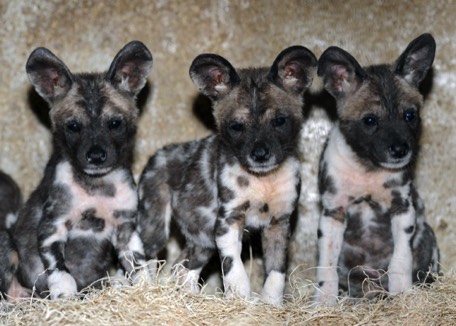
This is the largest African canid and is the world's second largest extant wild canid, behind only thegray wolf,. Adults typically weigh 18–36 kilograms (40–79 lb).[2][3] A tall, lean animal, it stands about 75 cm (30 in) at the shoulder, with a head and body length of 75–141 cm (30–56 in) plus a tail of 30 to 45 cm (12 to 18 in). Animals in southern Africa are generally larger than those in eastern or western Africa.
Little sexual dimorphism is shown, though judging by skeletal dimensions, males are usually 3–7% larger. It has a dental formula of
3.1.4.2
3.1.4.3
for a total of 42 teeth. The premolars are relatively large compared with those of other canids, allowing it to consume a large quantity of bone, much like the hyena.[4] The heel of the lower carnassial M1 is crested with a single cusp, which enhances the shearing capacity of teeth and thus the speed at which prey can be consumed. This feature is called trenchant heel and is shared with two other canids: the Asiandhole and the South American bush dog.
The African wild dog may reproduce at any time of year, although mating peaks between March and June during the second half of the rainy season. The copulatory tie characteristic of mating in most canids has been reported to be absent[5] or very brief (less than one minute)[6]in the African wild dog, possibly an adaptation to the prevalence of larger predators in its environment.[7] Adult females possess 12 to 14 teats. [8] Litters can contain 2–19 pups, though ~10 is the most common.[9] The time between births is usually 12–14 months, though it can also be as short as six months if all of the previous young die. The typical gestation period is between 60 and 80 days.[10] Pups are usually born in dens dug and abandoned by other animals, such as the aardvark. Weaning takes place at about 10-11 weeks;[8] however, all-male packs without adult females have been recorded successfully raising pups from 5 weeks of age.[8] Litters can contain 2–19 pups, though ~10 is the most common. After three months, the pups leave the den and begin to run with the pack. At the age of eight to 11 months, they can kill small prey, but depend on the pack kills for most of their food. They do not become proficient hunters until the age of 12–14 months. Wild dogs reach sexual maturity at the age of 12–18 months.
Females will disperse from their birth pack at 14–30 months of age and join other packs that lack sexually mature females. Males typically do not leave the pack in which they were born. This is unusual among social mammals, among which the core pack tends to consist of related females. Among African wild dogs, females compete for access to males that will help rear their offspring. In a typical pack, males outnumber females by a factor of two to one, and only the dominant female can usually rear pups. This atypical situation may have evolved to ensure that packs do not overextend themselves by attempting to rear too many litters at the same time.[11] The species is also unusual in that some members of the pack, including males, may be left to guard the pups while the others, including the mothers, join the hunting group. The practice of leaving adults behind to guard the pups may decrease hunting efficiency in smaller packs.[12]